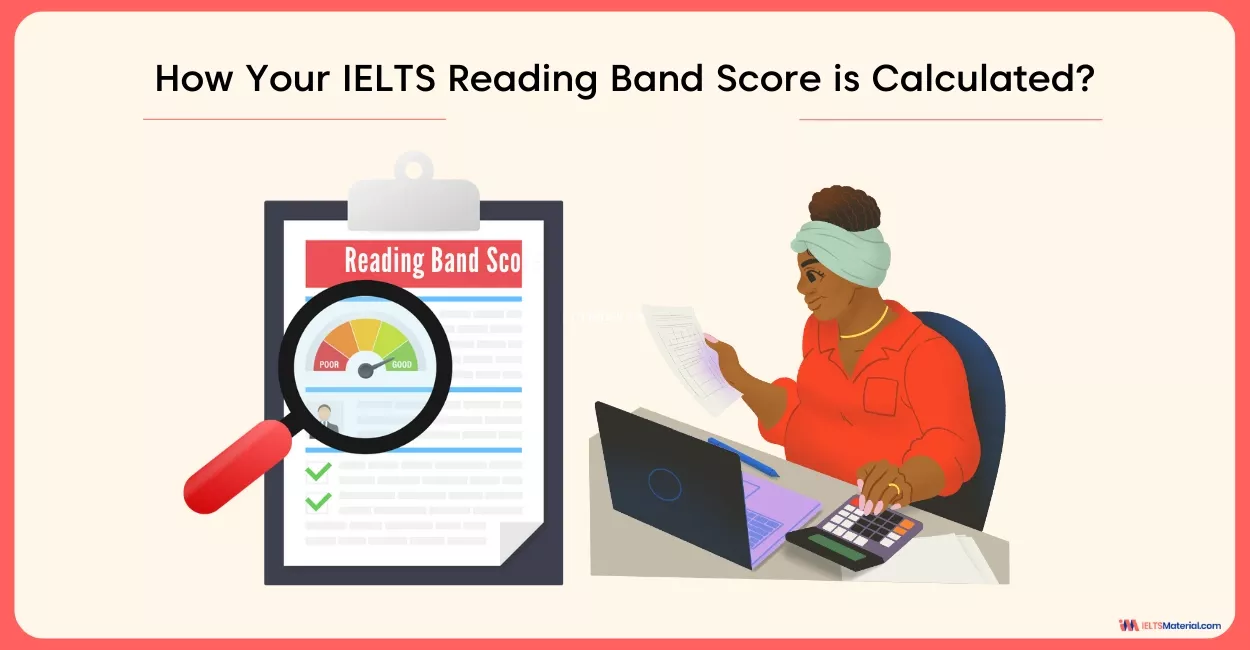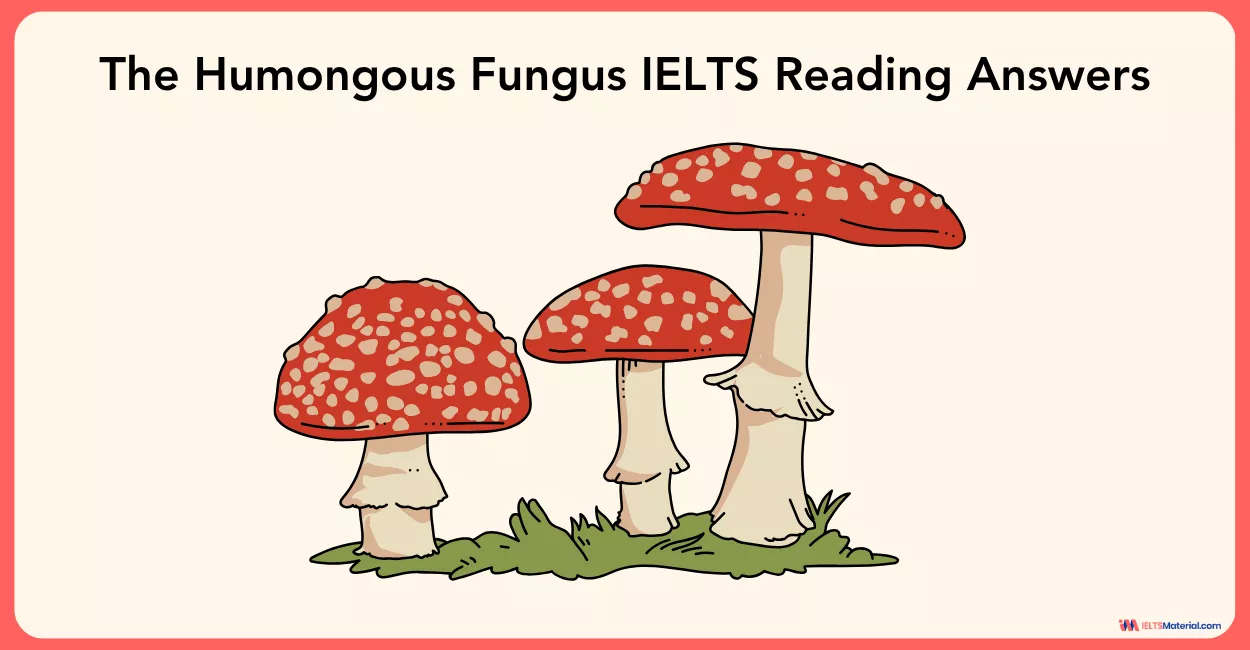The Humongous Fungus IELTS Reading Answers
9 min read
Updated On
-
Copy link
Get complete IELTS Reading answers for “The Humongous Fungus” with exact answer locations, clear explanations, and expert tips in this comprehensive blog and master all question types and improve your reading score.
Table of Contents

Limited-Time Offer : Access a FREE 10-Day IELTS Study Plan!
The IELTS Reading Module assesses your ability to understand, interpret, and analyse a variety of texts under time pressure. With consistent practice, it can become your highest-scoring section by improving skills such as skimming, scanning, and understanding paraphrased information.
The passage “The Humongous Fungus” is a real IELTS Academic Reading test passage, providing an excellent opportunity to practise under exam conditions. There are two types of questions in this passage. They are:
By solving and reviewing Sample Reading Questions from past IELTS papers, you can ensure that your Reading skills are up to the mark. Take the practice test below and check your score with the answers for The Humongous Fungus!
The Humongous Fungus IELTS Reading Passage
You should spend about 20 minutes on Questions 1-13 which are based on the Reading Passage.
- If you were asked what is the largest organism in the world, what would your answer be? A blue whale or a redwood tree? Or perhaps a giant squid? You would be wrong. But this is understandable because the world's largest organism is largely hidden from sight and was discovered only relatively recently in 1998 in the soil of Oregon's Blue Mountains. It is a fungus nearly ten square kilometers in area and one meter deep. It may be not only the largest single organism in the world but also one of the oldest. Based on its current rate of growth, the fungus is thought to be around 2,400 years old; however, it is also possible that it has been growing for the past 8,650 years. Commonly known as the honey mushroom, the only visible evidence for the organism on the surface is groups of golden mushrooms that grow in forests during the autumn.
- The discovery of the organism came about when Catherine Parks, a scientist at the Pacific Northwest Research Station in Oregon, heard about trees dying from root rot in a forest east of Prairie City, Using aerial photographs, she identified an area of dying trees stretching over a 5.6 kilometer area. She then collected samples from the roots of these trees. When she looked at the samples, Parks was able to confirm that many of the samples were infected by the same organism; the fungus had grown bigger than any other creature known to science. A combination of good genes and stable conditions has enabled it to spread. In addition, the dry climate of the region makes it difficult for new fungi to establish themselves and compete with established fungi.
- The technique for identifying the fungus was developed in 1992, when the first gigantic fungus was discovered in Michigan. A PhD biology student, Myron Smith, discovered it in a hardwood forest, when he and his team were trying to find the boundaries of individual fungi. After a year of testing, they still had not found the boundary of a particular fungus. The next thing they did was develop new genetic tests to see if the DNA from the samples was from a single individual fungus and not closely related individuals. Eventually, they realized that they had found a 1,500- year-old fungus that weighed over 90 metric tonnes.
- The honey mushroom fungus is the cause of a root disease that kills many trees in the US and Canada. It has fine filaments or tubes that grow along tree roots and connect together to form a mat. The mat then slowly consumes the food source: it produces chemicals that digest carbohydrates from the tree and interfere with the tree's ability to absorb water and nutrients, eventually leading to the death of the host organism. As well as producing 61 feeding filaments, the honey fungus is able to spread by producing string-like growths that reach out to find new potential food sources. The fungus spreads very slowly over hundreds of years, seeking out food and killing its victims. Not surprisingly, forest service scientists are interested in learning to control the fungus but they also realize that it has an important role to play in the forest's ecology.
- Fungi have both beneficial and harmful effects. They are essential because they decompose or break down waste matter on the forest floor and recycle nutrients. They are also central to many processes that are important to humans: they are vital to the process of making many kinds of food, including cheese, bread and wine. They have been used in the production of medicines, and particularly antibiotics. Even the golden mushrooms produced by the honey mushroom fungus are edible, though apparently not very tasty. On the other hand, fungi also form a major group of organisms harmful to plants and animals. Some mushrooms produced by fungi, such as the death cap mushroom and the fool's mushroom, are extremely poisonous to humans. Fungi can spoil food which has been stored, and of course they can kill trees and other plants.
- Although to humans the idea of an enormous organism silently growing underground seems very strange, Tom Volk, a biology professor at the University of Wisconsin-La Crosse, explains that this may be in the nature of things for a fungus. 'We think that these things are not very rare,’ he says. 'We think that they're in fact normal.
Limited Seats are Available for our IELTS Webinars! Book yours now!
The Humongous Fungus Reading Questions
Question 1 to 7
Below are given certain statements, the candidate needs to answer with True, False, or Not Given.
TRUE: If you find the question matching the information provided
FALSE: If you find the question opposite to the information provided.
NOT GIVEN: In case, there is no information given.
1. The fungus is perhaps the world's oldest living organism.
2. Catherine Parks wanted to work in Oregon.
3. Photos taken from the air helped her to locate the fungus.
4. Myron Smith developed a test to see which organisms are related to fungi.
5. The fungus damages trees by digesting carbohydrates that are part of the tree.
6. The mushrooms from the honey mushroom fungus are poisonous to humans.
7. The fungi are the Largest group of organisms harmful to humans.
Question 8 to 13:
Direction for questions from 8 to13:
The candidate needs to fill the answer with no more than two words. You need to fill answers in given spaces from 8 to13.
8. The Largest known organism is a fungus, the only _________ signs of which are mushrooms that appear in autumn.
9. The fungus was discovered when a scientist was studying _________ across a large area of forest in Oregon.
10. The fungus is responsible for all _________ that kills the trees.
11. Scientists determined that the fungus was a single organism by using _________ to see if DNA samples were from the same individual.
12. Although the concept of an enormous organism living _________
13. is strange to humans, scientists think it may be _____.
Boost your IELTS Academic Reading score today! Grab Get Your IELTS Reading Ebook Now!
The Humongous Fungus IELTS Reading Answers with Explanation
Let’s now review the answers to the questions from the passage in the reading section, The Humongous Fungus IELTS Reading Answers, and assess your improvement for a high IELTS Reading band score.
1. Answer: TRUE
Keywords: It may be not only the largest single organism in the world but also one of the oldest.
Location of keywords: Paragraph A; Line 7
Explanation: Confirms the organism’s size and age as described in the passage.
2. Answer: NOT GIVEN
Keywords: –
Location of keywords: –
Explanation: The passage provides no information on this statement.
3. Answer: TRUE
Keywords: Using aerial photographs, she identified an area of dying trees stretching over a 5.6 kilometre area. She then collected samples from the roots of these trees. When she looked at the samples, Parks was able to confirm that many of the samples were infected by the same organism; the fungus had grown bigger than any other creature known to science.
Location of keywords: Paragraph B; Lines 2–4
Explanation: Confirms how the organism’s size was determined and verified scientifically.
4. Answer: FALSE
Keywords: A PhD biology student, Myron Smith, discovered it in a hardwood forest, when he and his team were trying to find the boundaries of individual fungi. The next thing they did was develop new genetic tests to see if the DNA from the samples was from a single individual fungus and not closely related individuals.
Location of keywords: Paragraph C; Line 2 & Line 4
Explanation: The passage contradicts the claim about discovery details, making it FALSE.
5. Answer: TRUE
Keywords: it produces chemicals that digest carbohydrates from the tree and interfere with the tree’s ability to absorb water and nutrients, eventually leading to the death of the host organism.
Location of keywords: Paragraph D; Line 3
Explanation: Explains how the fungus kills trees, confirming the statement.
6. Answer: FALSE
Keywords: Even the golden mushrooms produced by the honey mushroom fungus are edible, though apparently not very tasty.
Location of keywords: Paragraph E; Line 5
Explanation: Contradicts any claim suggesting these mushrooms are inedible.
7. Answer: NOT GIVEN
Keywords: –
Location of keywords: –
Explanation: No information is provided in the passage.
8. Answer: visible
Keywords: Commonly known as the honey mushroom, the only visible evidence for the organism on the surface is groups of golden mushrooms that grow in forests during the autumn.
Location of keywords: Paragraph A; Last line
Explanation: Confirms what is visible on the surface.
9. Answer: trees dying / dying trees
Keywords: The discovery of the organism came about when Catherine Parks, a scientist at the Pacific Northwest Research Station in Oregon, heard about trees dying from root rot in a forest east of Prairie City.
Location of keywords: Paragraph B; Line 1
Explanation: Confirms the observation of dying trees led to the discovery.
10. Answer: Root disease
Keywords: The honey mushroom fungus is the cause of a root disease that kills many trees in the US and Canada.
Location of keywords: Paragraph D; Line 1
Explanation: Identifies the disease caused by the fungus.
11. Answer: Genetic tests
Keywords: The next thing they did was develop new genetic tests to see if the DNA from the samples was from a single individual fungus and not closely related individuals.
Location of keywords: Paragraph C; Line 4
Explanation: Confirms the type of tests conducted to verify the fungus.
12. Answer: Underground
Keywords: Although to humans the idea of an enormous organism silently growing underground seems very strange,
Location of keywords: Paragraph F; Line 1
Explanation: Confirms the organism grows primarily underground.
13. Answer: normal
Keywords: ‘We think that they’re in fact normal.’
Location of keywords: Paragraph F; Last line
Explanation: Confirms the observation about the organism being normal in its growth.
Tips to Ace Different Types of Questions in "The Humongous Fungus - Reading Passage"
Let us check out some quick IELTS Exam Preparation Tips for Band Score of 8+ to answer the types of questions in the Reading Answers.
True/False/Not Given
You need to decide whether statements agree with the information in the passage (True), contradict it (False), or cannot be determined (Not Given). Here are some tips to ace True/False/Not Given:
- Underline Keywords in the Statement – Helps you locate relevant sentences in the passage.
- Scan for Synonyms and Paraphrases – The passage rarely uses the exact words.
- Avoid Assumptions – Base your answer only on the text, not your knowledge.
- Carefully Compare Statement and Passage – True = matches, False = contradicts, Not Given = not mentioned.
- Watch for Qualifiers – Words like all, some, always, never can change the answer.
Summary Completion
- Pay attention to the word limit – Always follow the instructions, e.g., ONE WORD or TWO WORDS ONLY.
- Identify keywords in the summary – Look for terms that will help you locate the relevant part of the passage.
- Scan the passage strategically – Focus on sections where the information matches the summary context.
- Look for synonyms and paraphrasing – The words in the passage may be different from those in the summary.
- Check grammar and meaning – Ensure your answer fits the sentence correctly and makes logical sense in context.
Want to boost your IELTS score? Enroll in our expert-led IELTS online classes today!
Practising passages like “The Humongous Fungus” helps you strengthen key reading skills, manage time effectively, and tackle different question types with confidence. Regular practice with answers and explanations will improve your accuracy and boost your IELTS Reading score. Keep practising with more IELTS Reading Recent Actual Tests and answers on IELTSMaterial.com to improve your speed, accuracy, and overall performance.
Check More IELTS Reading Answers
Practice IELTS Reading based on question types

Start Preparing for IELTS: Get Your 10-Day Study Plan Today!
Recent Articles

Nehasri Ravishenbagam

Haniya Yashfeen

Haniya Yashfeen

Haniya Yashfeen




Post your Comments
1 Comment